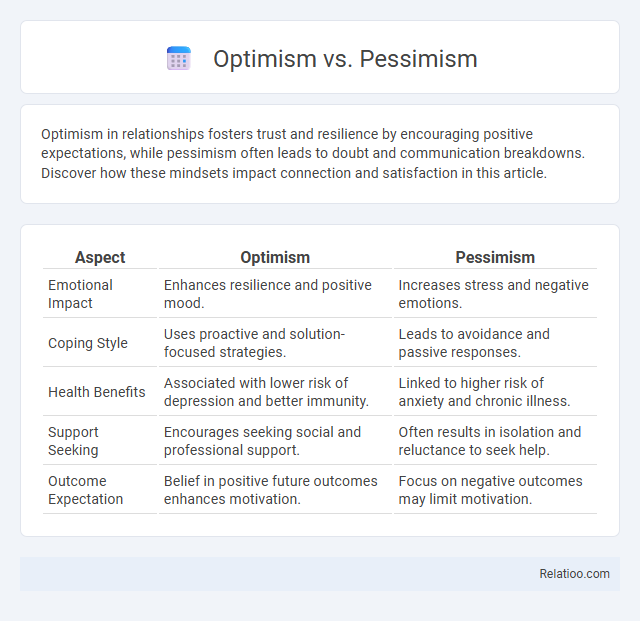Optimism in relationships fosters trust and resilience by encouraging positive expectations, while pessimism often leads to doubt and communication breakdowns. Discover how these mindsets impact connection and satisfaction in this article.
Table of Comparison
| Aspect | Optimism | Pessimism |
|---|---|---|
| Emotional Impact | Enhances resilience and positive mood. | Increases stress and negative emotions. |
| Coping Style | Uses proactive and solution-focused strategies. | Leads to avoidance and passive responses. |
| Health Benefits | Associated with lower risk of depression and better immunity. | Linked to higher risk of anxiety and chronic illness. |
| Support Seeking | Encourages seeking social and professional support. | Often results in isolation and reluctance to seek help. |
| Outcome Expectation | Belief in positive future outcomes enhances motivation. | Focus on negative outcomes may limit motivation. |
Defining Optimism and Pessimism
Optimism is the mindset characterized by expecting positive outcomes and focusing on opportunities for growth, while pessimism entails anticipating negative results and emphasizing potential obstacles. Your attitude, shaped by these outlooks, significantly influences decision-making and resilience in the face of challenges. Understanding the difference between optimism and pessimism helps you cultivate a balanced perspective for improved mental well-being and problem-solving.
Psychological Roots of Optimism and Pessimism
Optimism and pessimism stem from deep psychological roots shaped by early life experiences, cognitive biases, and neural pathways influencing emotional regulation and expectation formation. Your attitude forms through these mental frameworks, where optimism correlates with adaptive brain functions promoting resilience, while pessimism often links to heightened sensitivity in areas related to fear and negativity processing. Understanding these psychological underpinnings helps you cultivate a balanced mindset, fostering an attitude that supports mental health and personal growth.
Impacts on Mental Health
Optimism fosters resilience and reduces stress by encouraging positive thinking patterns, leading to lower rates of depression and anxiety. Pessimism, linked to chronic stress and negative health outcomes, increases vulnerability to mental health disorders by amplifying worry and helplessness. A balanced attitude that integrates realistic optimism improves emotional regulation and supports overall psychological well-being.
Optimism vs Pessimism in Daily Decision-Making
Optimism enhances your daily decision-making by fostering confidence in positive outcomes and encouraging risk-taking, which can lead to growth and success. Pessimism, on the other hand, often results in cautious or avoidant choices that prioritize safety but may limit opportunities and innovation. Your attitude, shaped by the balance between optimism and pessimism, fundamentally influences how you assess challenges and opportunities throughout each day.
Effects on Relationships and Social Life
Optimism enhances relationships by fostering trust, effective communication, and emotional support, leading to stronger social bonds and increased satisfaction. Pessimism often creates barriers such as mistrust and negative expectations, which can strain interactions and decrease social engagement. A positive attitude cultivates empathy and openness, improving conflict resolution and promoting healthier, more fulfilling social connections.
The Role of Optimism and Pessimism in Workplace Success
Optimism in the workplace fosters resilience, enhances problem-solving abilities, and boosts team collaboration, directly contributing to higher productivity and employee satisfaction. Pessimism, while often viewed negatively, can play a critical role in risk assessment and identifying potential obstacles, helping to prevent costly mistakes. Your attitude, shaped by a balance between optimism and pessimism, ultimately influences decision-making and drives career success by aligning motivation with realistic expectations.
How Optimism and Pessimism Shape Coping Strategies
Optimism fosters proactive coping strategies by encouraging positive reframing and persistence in the face of challenges, enhancing mental resilience and problem-solving skills. Pessimism often leads to avoidant or emotion-focused coping, which may increase stress and hinder effective resolution of adversity. Your attitude, shaped by these outlooks, critically influences how you manage stress and recover from setbacks, determining overall psychological well-being.
Genetics and Environmental Influences
Genetics contribute significantly to optimism and pessimism by influencing neurochemical pathways related to mood regulation, such as serotonin and dopamine levels governed by variations in the SLC6A4 and DRD4 genes. Environmental influences, including early childhood experiences, social interactions, and exposure to stress, shape attitude development by modifying gene expression through epigenetic mechanisms. The interplay between inherited genetic predispositions and environmental factors ultimately determines an individual's dominant outlook and adaptive psychological resilience.
Shifting Perspectives: Cultivating a Balanced Mindset
Shifting perspectives from pessimism to optimism involves recognizing the impact of your internal dialogue on emotional well-being and decision-making. Cultivating a balanced mindset means integrating realistic optimism with constructive skepticism to navigate challenges effectively. You can enhance resilience and clarity by consciously adjusting your attitude to focus on opportunities without ignoring potential risks.
Conclusion: Finding Harmony Between Optimism and Pessimism
Balancing optimism and pessimism cultivates a realistic yet hopeful attitude that enhances decision-making and emotional resilience. Embracing optimism encourages motivation and opportunity recognition, while integrating a healthy dose of pessimism safeguards against potential risks and disappointment. Developing an adaptive attitude that harmonizes these perspectives promotes nuanced thinking and empowers individuals to navigate life's challenges effectively.

Infographic: Optimism vs Pessimism
 relatioo.com
relatioo.com